What’s the difference between Actiontec Screenbeam and Airtame 2? To help you make the right choice for your needs, we want to give a fair comparison between the two.
Actiontec Screenbeam vs Airtame 2
Both Screenbeam and Airtame 2 are high-quality wireless streaming solutions designed for education and small to larger enterprises. At first glance, you might think the main difference lies in the price tag. However, there are other major considerations to keep in mind.
Highlights
- Screenbeam devices let you stream content between two Miracast-enabled devices. Screenbeam is therefore incompatible with all Apple products.
- The Screenbeam receiver, similar in size to Apple TV, plugs via HDMI cable to a TV or projector.
- With the exception of Windows Mobile, Airtame 2 is a one-size-fits-all cross-platform device.
- The Airtame 2 device has a small and sleek design that connects to the HDMI port of any TV or projector.
- Screenbeam mirrors from one source to a single screen or projector.
- Airtame 2 allows mirroring from one source to multiple screens or projectors at the same time.
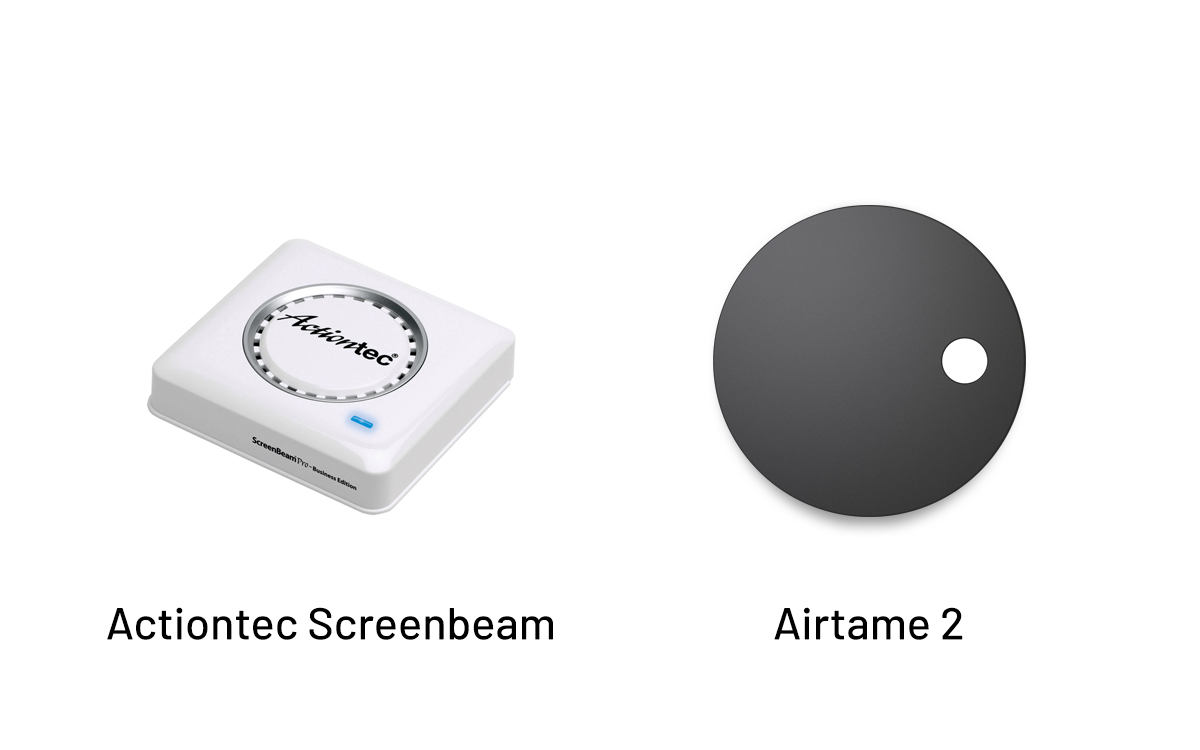
Oh, by the way, we’re always happy to tell you more about Airtame
Let’s find a time to talkIn a nutshell
Screenbeam has a wide variety of products with different features and price points. In this article, we’ll review the Screenbeam 750 and Screenbeam 950 as they are most comparable with Airtame 2 in regards to features, use, and price.
Before diving into the details, let’s look at the overview:
| Features & Price | Screenbeam 750 | Screenbeam 950 | Airtame |
|---|---|---|---|
| Image Resolution | 1920×1080 Full HD | 1920×1080 Full HD | 1920×1080 Full HD |
| Network Security | WPA2, WPS virtual PBC, AES 128-bit | WPA2, WPS virtual PBC, AES 128-bit | WPA2-personal/enterprise, SSL certificates |
| Ethernet | Yes, port | Yes, port | Micro USB Adapter |
| Wireless channels | 2.4Ghz | 2.4 Ghz and 5 Ghz | 2.4 Ghz and 5 Ghz |
| Pin code Support | Yes | Yes | Yes |
| Presenter Tools | Yes | Yes | No |
| Digital Signage | No | No | Yes |
| Content Protection (HDCP) | Yes | Yes | No |
| Extended Desktop | Yes | Yes | Yes (Single Window Sharing) |
| One-to-many screens | No | No | Yes |
| Split-screen sharing | No | No | No |
| Mobile Streaming | Windows and Android | Windows and Android | Android and iOS |
| Requires Internet to Stream | No | No | No |
| Touchscreen Support | Yes | Yes | No |
| Powered by | A/C | A/C | A/C or Micro USB |
| Price | $ 203-220 | $ 258-340 | $ 299 |
Miracast Only vs Cross-Compatibility
Screenbeam streams using Miracast, a standard for screen mirroring technology. The technology is included in most newer Windows PCs (i.e., 8-10+), Windows mobile devices, and Android (4.2+) products. Note that Miracast technology is not included in Mac or iOS devices.
For Miracast to work, certain hardware is required. Therefore, devices running these OS’s might still not support Miracast natively, although, there is an option to purchase a USB or mini USB external wireless display transmitter.
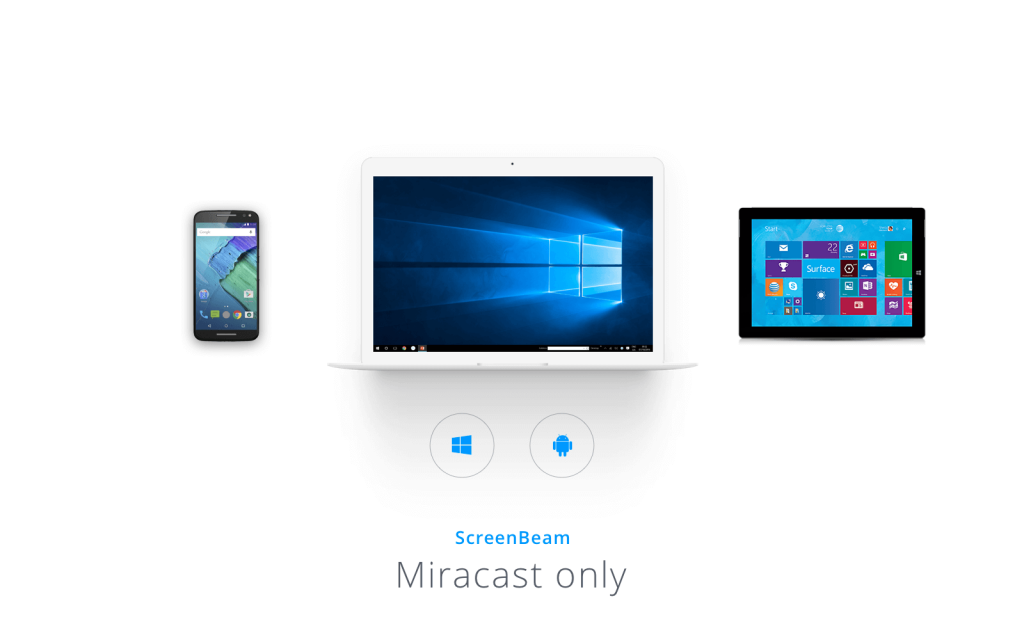
In comparison, Airtame 2 uses its own streaming technology. Airtame 2 is also cross-compatible with multiple platforms, making it a BYOD-friendly alternative. Here is what users of different platforms can expect using either Screenbeam or Airtame 2.
Apple users can do full screen mirroring from Macbooks with Airtame 2 and use AirPlay iOS mirroring to mirror iPad and iPhone screens. Screenbeam is not compatible with any Apple products.
Windows users are happily embraced in the wireless arms of both Airtame 2 and Screenbeam. Windows devices, including Surface and Surface Pro tablets. Airtame 2 does not, however, support Windows mobile devices.
Linux users are a rare type, but luckily for them, Airtame 2 is a proud supporter of the powerful penguin party in audio and video. Screenbeam does not offer support for Linux.
Chromebook users are a smaller group but growing in numbers, especially in schools. Screenbeam, unfortunately, doesn’t support Chromebook. Airtame 2 offers support with full HD mirroring, although streaming with audio is not yet available. We intend to change this very soon.
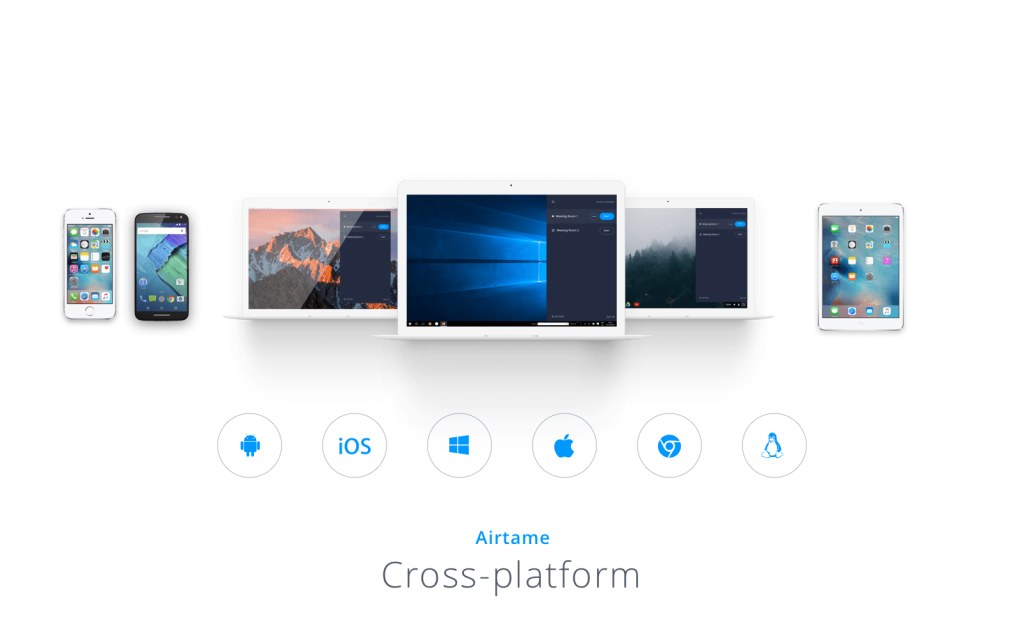
Wall-mounted and Stationary vs Compact and Portable
Screenbeam is a larger square-shaped device about the size of an Apple TV. When using a wall-mounted TV with Screenbeam, you would need to secure the device on top of the TV, mount it to a wall, or have it sit on a sturdy surface.
Bear in mind, Screenbeam devices can only be powered by an AC adapter.
Airtame 2 device is lightweight, compact, and flexible with regards to setup, so you can mount it to the wall via the included magnetic mount, or directly on the TV or projector. No drilling into holes is necessary.
Just as with the Screenbeam, you’ll need to use the AC adapter included in the box (thought we will soon be launching a custom PoE adapter to power the device and connect to your network simultaneously.
Airtame 2 fulfills the needs of a customizable wireless streaming solution, but it’s also a great companion to the traveling presenter. Use a power bank and Airtame 2’s built-in WiFi to start a wireless presentation within a matter of minutes.
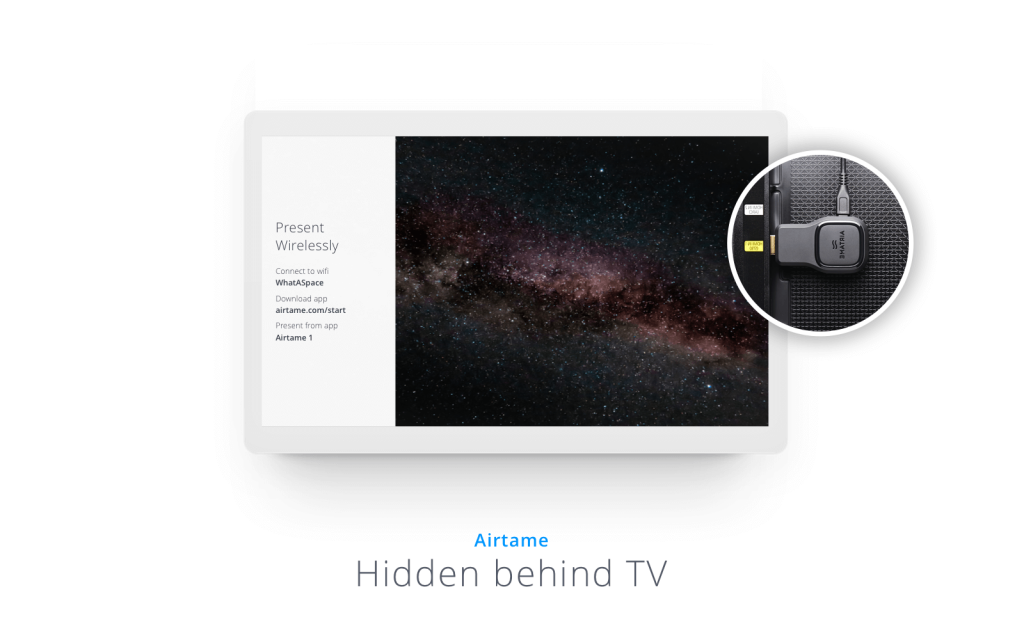
Screenbeam CMS vs Airtame Cloud
If there is anything that can cure an IT administrator’s headache, it is a centralized control system. Luckily for them, both Screenbeam and Airtame offer systems for monitoring multiple presentation devices, but with a few important differences.
The comprehensive and mostly unstyled Screenbeam CMS is a Windows-only application. It allows the administrator to monitor status, organize and group multiple Screenbeam receivers according to location, push updates, reset and change individual preferences, and change network settings.
With the Screenbeam CMS, you have to be on the same network or another network that can access the network that the Screenbeam units are on, for example, with a VPN.
Additional features are: Event Scheduler and Logs Management. Event Scheduler allows for running different settings at a period of time for one, a group, or all receivers, and the Log Management captures logs and warning messages from the receivers of your choice.
A Screenbeam CMS perpetual license is included in the purchase but is only valid for 3 years. When it expires, you’ll have the choice to either re-up on a subscription for approximately $120 or keep using outdated software.
The Screenbeam 950 and 750 devices both support this CMS. You can read more about the Screenbeam CMS here.
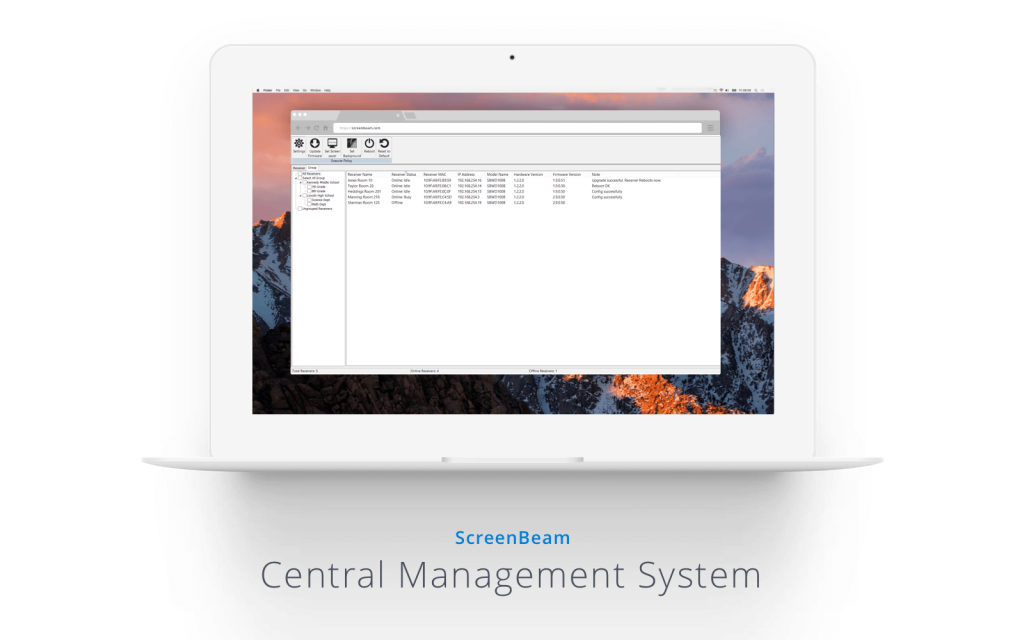
Airtame Cloud is a cloud-based application that uses a web browser. It is designed to be both user-friendly and a highly functional management system. Airtame Cloud allows administrators to monitor status, rename, organize and group multiple devices, update firmware, change individual settings such as enabling pin code, digital signage, and network settings.
You can customize settings for individual devices or for multiple devices at once. Since Airtame Cloud is cloud-based, you can manage and update devices from a remote location.
Airtame Cloud is free of charge, so whether you use three or a hundred devices, it is a great and practical way to manage your Airtames. You can read more about the Airtame Cloud here.
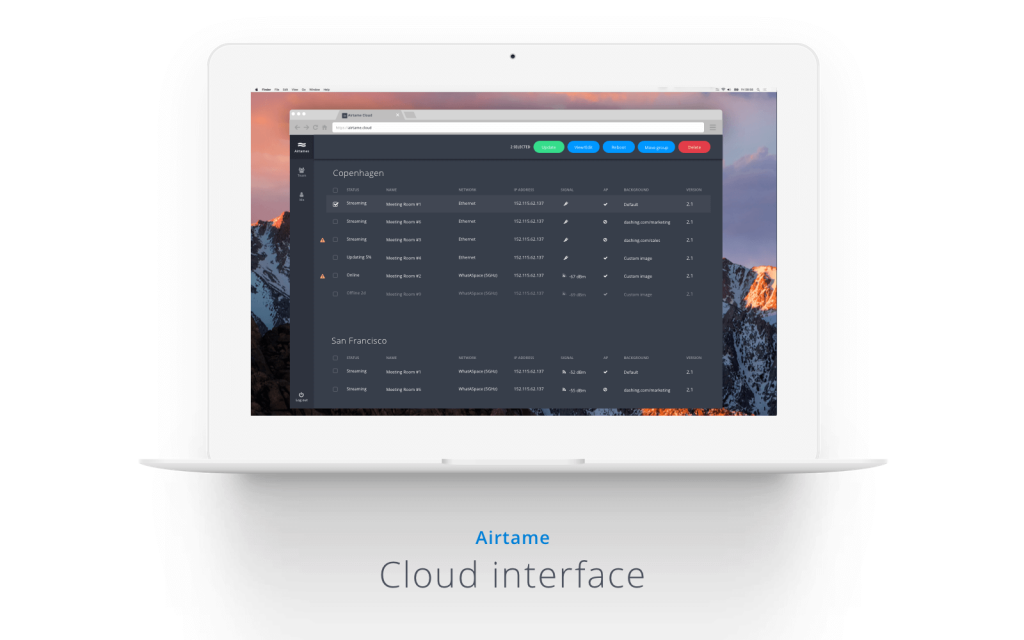
Digital Signage
Screenbeam and Airtame 2 devices allow users to personalize their default backgrounds. With Screenbeam, you can change the background images on the welcome screen or set a screensaver with an image of your choice.
With Airtame’s customizable Homescreen, you can customize what’s shown on your Airtame-powered screens when no one is streaming to them. Homescreen also allows for an easy and intuitive overview of all your Airtame devices. This gives the Airtame Homescreen a practical use. It is a digital signage solution that’s useful for a range of different needs.
Airtame currently has four beta apps – Google Slides (allowing you to present public presentations as homescreens); Trello (where you can connect and present project or team dashboards); World Clock (presenting up to four different time zones); and Unsplash (showcasing beautiful photography on your screens, based on a selected descriptive tag).
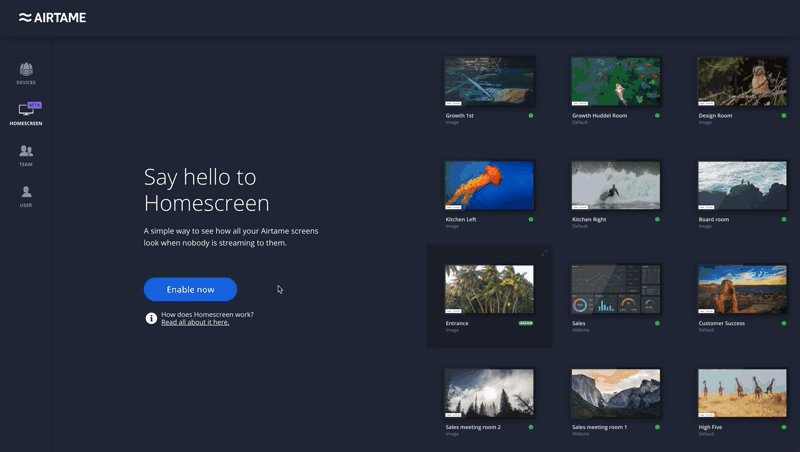
Bottom Line
With work environments moving from the traditional cubicle setup to open collaborative spaces, there is an ever-growing need to present on the big screen. More often than not, people bringing their own devices to work need a flexible wireless screen sharing solution, which your environment should have available.
However, if you can characterize your office or classroom as an all-Windows 10 and/or Android 4.2+ environment, with no need to simultaneously stream to multiple screens or presenting on-the-go, Screenbeam could be a solution for you. Before you buy, we recommend taking a closer look at the multiple Windows-based features Screenbeam has to offer. Here is a good place to start.
If your environment consists of users on multiple platforms, including Windows, Apple, Linux, and Chromebook, Airtame 2 is a better choice for supporting BYOD classrooms and offices. Also, if you’re looking for a device that can do both screen sharing and digital signage, Airtame 2 is most likely the solution for you.
As with Screenbeam, we recommend you take a closer look at the features Airtame currently has to offer and what’s to come. Here is a good place to start:
- Airtame 2 product page
- What is Airtame 2
- Product roadmap
- Chromecast vs Airtame 2
- Apple TV vs Airtame 2
- Microsoft Wireless Display Adapter vs Airtame 2
- ClickShare Vs Airtame 2
- Wireless Streaming for HDMI overview
We aim to be as objective as we can in this article to give a fair comparison between Screenbeam and Airtame 2.

